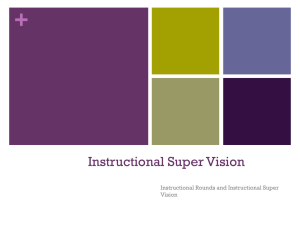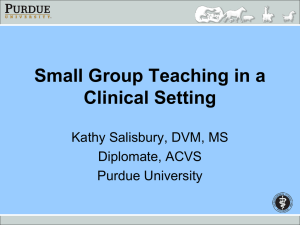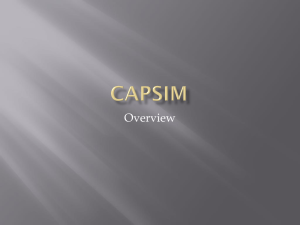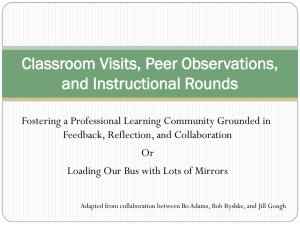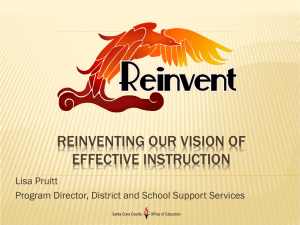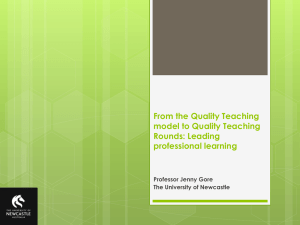Instructional Rounds - School Administrators of Iowa
advertisement
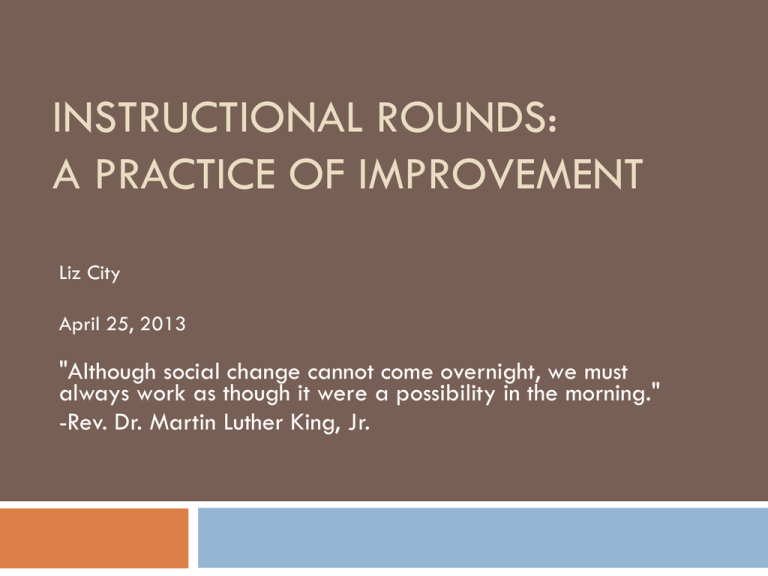
INSTRUCTIONAL ROUNDS: A PRACTICE OF IMPROVEMENT Liz City April 25, 2013 "Although social change cannot come overnight, we must always work as though it were a possibility in the morning." -Rev. Dr. Martin Luther King, Jr. Objectives Understand the “what,” “why,” and “how” of rounds Leave with a tool or idea you will apply in your practice Today’s Agenda Review objectives and agenda The Instructional Core What is Instructional Rounds? Why do rounds? Task How do we do rounds? Preparing for rounds: Description, Problem of Practice Observation, Debrief Analysis, Prediction, Next Level of Work So what? Making connections between rounds and your work Introduce yourself and discuss… Table for 3: Something you know (or think you know) about rounds. Table for 4: Something you want to know about rounds. Table for 2: Complete the sentence: “I learn best when . . .” The Instructional Core What’s the work? The Instructional Core Student Teacher Content Save the Last Word Text: Instructional Rounds in Education, Chapter 1 (http://bit.ly.irch1) Groups of 4 Select which of your quotes you would like to share. Cite page of your quote and give your group members a moment to find the quote Read passage to group with no commentary Pause for a moment for each person to think Each person has ~1 min to comment Reader has ~2 min to respond – the last word Repeat for each participant The Instructional Core Agree? Principle 1: Increases in student learning occur only as a consequence of improvements in the level of content, teachers’ knowledge and skill, and student engagement. Student Principle 2: If you change one element of the instructional core, you have to change the other two. Principle 3: If you can’t see it in the core, it’s not there. Principle 4: Task predicts performance. Principle 5: The real accountability system is in the tasks that students are asked to do. Argue? Aspire? Task Teacher Content Principle 6: We learn to do the work by doing the work. Principle 7: Description before analysis, analysis before prediction, prediction before evaluation. In Chapter 1, Instructional Rounds in Education What is (and isn’t) instructional rounds? Classroom observations Network Improvement plans What it is and isn’t . . . ∅ “Walkthroughs” or “drive-bys Rounds is descriptive, analytic, inferential ∅ A teacher evaluation tool ∅ NO assessment of individual teachers Separate the person from the practice; focus on the practice ∅ An implementation check Rounds focuses on patterns of practice and predicted results, not compliance with directives ∅ Training for supervision Rounds focuses on collective learning rather than individual supervisory practice—mirror, not window ∅ A “program” or a “project”; an add-on, another initiative among many Rounds is a practice, designed to support an existing improvement strategy at the school or system level The way we do the work Graphical overview of rounds process OBSERVATION/DESCRIPTION PROBLEM OF PRACTICE NEXT LEVEL OF WORK THEORY OF ACTION ANALYSIS: THEMES/PATTERNS IMPROVEMENT STRATEGY PREDICTION: “IF YOU WERE A STUDENT. . .WHAT WOULD YOU KNOW & BE ABLE TO DO. . ?” Sequential Overview of the Rounds Process Preparatory work with host school and network Problem of practice development Logistics Visit Problem of Practice Observation of Practice Observation Debrief (Describe, Analyze, Predict) Next Level of Work Post visit follow-up with host and network Sharing data Following up (at host school and network) Why do rounds? Instructional core and task State three ways you could describe the level and type of learning in your school system without using test scores. SIX WAYS OF DEMONSTRATING LEARNING Level 1: FIND A FACT IN A TEXT IN RESPONSE TO A QUESTION Level 2: REMEMBER SOMETHING SOMEONE ELSE HAS TOLD YOU AND REPEAT IT Level 3: REMEMBER A PROCEDURE THAT SOMEONE ELSE HAS TAUGHT YOU AND APPLY IT ACCURATELY AND FLUENTLY Level 4: CHOOSE A PROCEDURE FROM AMONG A NUMBER YOU HAVE LEARNED, APPLY IT ACCURATELY AND FLUENTLY, EXPLAIN WHY YOU CHOSE IT, AND WHY IT MIGHT BE BETTER THAN ANOTHER Level 5: USING A BODY OF EVIDENCE, MAKE AN ARGUMENT ABOUT WHAT YOU THINK IT MEANS, ANTICIPATE AND RESPOND TO COUNTER ARGUMENTS Level 6: TEACH SOMETHING YOU THINK YOU KNOW TO SOMEONE ELSE Program for International Student Assessment, http://nces.ed.gov/surveys/pisa/index.asp The Instructional Core Student Principle 1: Increases in student learning occur only as a consequence of improvements in the level of content, teachers’ knowledge and skill, and student engagement. Principle 2: If you change one element of the instructional core, you have to change the other two. Task Teacher Content Principle 3: If you can’t see it in the core, it’s not there. Principle 4: Task predicts performance. Principle 5: The real accountability system is in the tasks that students are asked to do. Principle 6: We learn to do the work by doing the work. Principle 7: Description before analysis, analysis before prediction, prediction before evaluation. In Chapter 1, Instructional Rounds in Education Grade What do you see? 8 7 6 5 4 3 2 1 0 8 7 6 5.78 5 4 3 2 1 0 K 6.37 4.97 4.34 3.62 2.88 1.94 0.99 0.02 1 2 3 4 Average Grade Level of Assignment 5 6 7 8 Grade Level Standard Source: Education Trust; John Holton, South Carolina Department of Education, analysis of assignments from 362 19 Elementary and Middle Schools in SC. Grade What do you see? 12 11 10 9 8 7 6 5 12 11 10 9 7.82 Grade 9 9.56 9.78 8.5 Grade 10 Average Grade Level of Assignment Grade 11 Grade 12 Grade Level Standard Source: Education Trust; John Holton, South Carolina Department of Education, analysis of English Language Art 20 Assignments in14 High Schools in South Carolina Why do rounds? A question you have to answer for yourself . . . My brief answer . . . EKG . . . Equity—To ensure that ALL children have access to powerful learning no matter which classroom they’re in Knowledge—To understand what kind of learning is happening in your system Group capacity—To build a shared language and understanding of powerful learning and teaching Why not do rounds? How do we do rounds? Prepare rounds? Practice rounds? Description Problem of practice Observation Debrief Developing the Discipline of Seeing Seeing is a discipline It’s like a muscle—it gets stronger with repetition Foundation of our practice 24 What do you see? Choose an image card. Without showing it to your partner, describe what you see on the card. Partners, create an image in your head based on your partner’s description. NOTE: It is okay to use any words you want to describe the image. Share the card. Partners: Does the description match the card? When you look at the card, what do you see? How would you describe it? Objectivity Judgmental Specific and Judgmental General and Judgmental Specific and Descriptive General and Descriptive Descriptive Specific Specificity General 26 Adapted from Learning Walkthough Guide, MA Dept. of Elementary & Secondary Education Description with Judgment “The teacher read from a book that was not at the appropriate level for the class.” “There was too much time on discussion, not enough time on individual work.” “The students conducted a sophisticated lab experiment.” Description without Judgment “Student 1 asked student 2: ‘What are we supposed to write down?’ Student 2 said, ‘I don’t know.’” “Students followed directions in the text to make circuit boards.” “Teacher introduced a writing prompt to students.” Instructional Rounds, p.85 Specificity of Evidence “Teacher introduced a writing prompt to students.” vs. “Prompt for student essays: “What role did symbolism play in foreshadowing the main character’ss dilemma?” Instructional Rounds, p. 93 Objectivity Judgmental Descriptive Specific and Judgmental General and Judgmental “The teacher read from the book, “There was too much time on Oliver Twist, which was not at the discussion, not enough time on appropriate level for the class.” individual work.” Specific and Descriptive General and Descriptive “Student 1 asked Student 2, ‘What are we supposed to write down?’ Student 2 said, ‘I don’t know.’” Specific “Teacher introduced a writing prompt to students.” Specificity General 30 Adapted from Learning Walkthough Guide, MA Dept. of Elementary & Secondary Education Overview of a Rounds Visit …Problem of Practice Observation of Practice Observation Debrief Describe Analyze Predict Next Level of Work 31 A Problem of Practice… …focuses on the observations across classrooms on one or two things contained in the core that the school is working on. Describing and Clarifying the Problem of Practice Host provides problem of practice Why select it? Who selects it? Where does it come from? What other background do outsiders (visitors) need to know about the problem and what the school/district has been doing to address it? Visitors ask clarifying questions About background and context—to get clarity. About what to look for in classrooms to reflect back to the school on the problem of practice. Problem of Practice After some initial growth in literacy and math performance, recently student performance on both benchmark and state tests is flattening. Most students are passing, but only half of the students are in the “proficient” category, with few in “advanced” on the state test. We may not be challenging students sufficiently in their daily work. What tasks are students being asked to do? What questions do you hear? Video: Practicing Observation Stick close to the instructional core and focused on the problem of practice Be specific, descriptive and not evaluative- take detailed notes! What are students saying and doing? What are teachers saying and doing? What is the task? Video: 1. Key Elements of Observing Practice: A Data Wise DVD and Facilitator’s Guide 2. Teaching for Deep Comprehension: A Reading Workshop Approach Overview of the Rounds Visit …Problem of Practice Observation of Practice Observation Debrief Describe Analyze Predict Next Level of Work 36 Overview of the Rounds Visit …Problem of Practice Observation of Practice Observation Debrief Describe Analyze Predict Next Level of Work 37 Remember the Problem of Practice! After some initial growth in literacy and math performance, recently student performance on both benchmark and state tests is flattening. Most students are passing, but only half of the students are in the “proficient” category, with few in “advanced” on the state test. We may not be challenging students sufficiently in their daily work. What tasks are students being asked to do? What questions do you hear? Where would you put your evidence? Objectivity Judgmental Specific and Judgmental General and Judgmental Specific and Descriptive General and Descriptive Descriptive Specific Specificity Adapted from Learning Walkthough Guide, MA Dept. of Elementary & Secondary Education General Descriptive Debrief On your own: Read through your notes. Star data that seem relevant to the problem of practice and/or data that seem important. Select 5-10 pieces of data and write each one on an individual sticky note. Share with your group: Help each other stay in the descriptive (not evaluative) voice. Everyone speaks once before anyone speaks twice. Analysis 1. 2. Analyze the descriptive evidence in your small group, placing sticky notes on chart paper, grouping them, and labeling groups. A sticky note can stand alone or be duplicated What groupings help you make sense of what you saw? What patterns do you see? Write statements or develop a model that describe the patterns you found in your data. 41 The Instructional Core Principle 4: Task predicts performance. Student Task Teacher Content 42 “Task Predicts Performance.” Predict what students are learning. If you were a student at this school and you did everything you were expected to do, what would you know and be able to do? 43 Overview of the Rounds Visit …Problem of Practice Observation of Practice Observation Debrief Describe Analyze Predict Next Level of Work 44 Next Level of Work Imagine if these data were from your school / district… Consider… What resources exist to support improvement? What initiatives are already in motion? What 3 detailed suggestions would you make to help the school move instruction to the next level? Next week By winter break By the end of the school year Graphical overview of rounds process OBSERVATION/DESCRIPTION PROBLEM OF PRACTICE NEXT LEVEL OF WORK THEORY OF ACTION ANALYSIS: THEMES/PATTERNS IMPROVEMENT STRATEGY PREDICTION: “IF YOU WERE A STUDENT. . .WHAT WOULD YOU KNOW & BE ABLE TO DO. . ?” Learnings . . . So what? Instructional Rounds compared to Supervision and Evaluation Instructional Rounds Supervision and Evaluation Learning stance Inquiry: Genuinely want to learn something ourselves Unit of improvement Meant to improve the collective (school, system) Lateral (peer-to-peer) Accountability Output Primary focus in the classroom Informative: Genuinely want someone else to learn something Main learners: The observers Main learner: The observed Meant to improve the individual Positional (top-down) Next level of work, Evaluative feedback, collective commitments prescriptions for next steps The teacher The instructional core, especially the students and the tasks they’re engaged in. In “Learning from Instructional Rounds,” by Elizabeth A. City, Educational Leadership, Vol. 69, No. 2, p. 36-41, October 2011. How is rounds different from walkthroughs? Lessons learned It’s a practice—it takes practice (lots of repetition!) Rounds is countercultural—and it’s easy to slip back into the default judgmental culture The interactions are what matter Rounds is something to do with teachers, not to them Rounds by itself is not enough—it needs to be part of an improvement strategy Rounds is not likely to yield strong results unless you have a clear theory about how rounds leads to desired outcomes Rounds is a powerful practice—it changes the way people see classrooms, focus their work, and talk So what for me? For us? What’s one tool or idea from today that you will apply in your practice? Why? How does the work of instructional rounds relate to or build upon other improvement processes already under way in your district/school(s)? How could rounds deepen and accelerate your work? What next? Classroom observations Network Improvement strategy Thank you!
